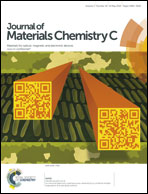Reversible thermal-mode control of luminescence from liquid-crystalline gold(i) complexes†
Abstract
The synthesis and characterisation of liquid-crystalline (LC) gold complexes designed to have a rod-like structure in a dimeric form are described, and the relationship between their photophysical properties and aggregated structure is discussed. The luminescence intensities of the complexes were enhanced in the condensed phase, meaning that the complexes showed aggregation-induced emission. Observed photoluminescence in the condensed phase could be assigned to a monomer emission; however, luminescence properties were strongly affected by the aggregated structures of the complexes. A reversible “on–off” switching of the luminescence induced by the phase transition between LC and isotropic phases is demonstrated. Moreover, complex 1b showed thermochromic photoluminescence controlled by the aggregated structure; the colour of luminescence could be reversibly controlled by the phase transition between crystalline and LC phases. These LC gold complexes show potential application as materials for novel light-emitting devices.


 Please wait while we load your content...
Please wait while we load your content...